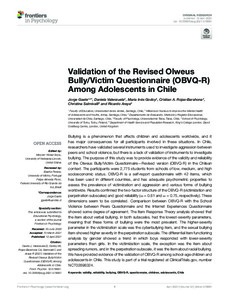Validation of the revised Olweus bully/victim questionnaire (OBVQ-R) among adolescents in Chile
Araya Ricardo; Salmivalli Christina; Gaete Jorge; Valenzuela Daniela; Rojas-Barahona Cristian A.; Godoy María Inés
https://urn.fi/URN:NBN:fi-fe2021100750245
Tiivistelmä
Bullying is a phenomenon that affects children and adolescents worldwide, and it has major consequences for all participants involved in these situations. In Chile, researchers have validated several instruments used to investigate aggression between peers and school violence, but there is a lack of validation of instruments to investigate bullying. The purpose of this study was to provide evidence of the validity and reliability of the Olweus Bully/Victim Questionnaire—Revised version (OBVQ-R) in the Chilean context. The participants were 2,775 students from schools of low, medium, and high socioeconomic status. OBVQ-R is a self-report questionnaire with 42 items, which has been used in different countries, and has adequate psychometric properties to assess the prevalence of victimization and aggression and various forms of bullying worldwide. Results confirmed the two-factor structure of the OBVQ-R (victimization and perpetration subscales) and good reliability (ω = 0.81 and ω = 0.75, respectively). These dimensions seem to be correlated. Comparison between OBVQ-R with the School Violence between Peers Questionnaire and the Internet Experiences Questionnaire showed some degree of agreement. The Item Response Theory analysis showed that the item about verbal bullying, in both subscales, had the lowest-severity parameters, meaning that these forms of bullying were the most prevalent. The higher-severity parameter in the victimization scale was the cyberbullying item, and the sexual bullying item showed higher severity in the perpetration subscale. The differential item functioning analysis by gender showed a trend in which boys responded with lower-severity parameters than girls. In the victimization scale, the exception was the item about spreading rumors, and in the perpetration subscale, it was the item about racial bullying. We have provided evidence of the validation of OBVQ-R among school-age children and adolescents in Chile.
Kokoelmat
- Rinnakkaistallenteet [19207]
